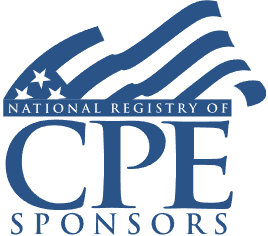S Corporation Formation Issues: Issuing Stock, Eligible Shareholders, Selecting a Year-End and Accounting Method

Course Details
- smart_display Format
On-Demand
- signal_cellular_alt Difficulty Level
Intermediate
- work Practice Area
Tax Preparer
- event Date
Tuesday, May 7, 2024
- schedule Time
1:00 p.m. ET./10:00 a.m. PT
- timer Program Length
110 minutes
-
BARBRI is a NASBA CPE sponsor and this 110-minute webinar is accredited for 2.0 CPE credits.
-
BARBRI is an IRS-approved continuing education provider offering certified courses for Enrolled Agents (EA) and Tax Return Preparers (RTRP).
This webinar will provide tax practitioners and business owners with a comprehensive overview of the tax issues that arise when forming a Subchapter S corporation. Our panel of pass-through experts will guide you through the shareholder eligibility requirements, issuing common stock, filing Form 2553, and selecting a year-end and accounting method.
Faculty

Mr. Jamison is Professor Emeritus of Accounting at Indiana University, Purdue University, Indianapolis (IUPUI). His principal area of specialization is S Corporations. He is the sole author of S Corporation Taxation, and co-author of Multistate Tax Guide to Pass-Through Entities, both of which are published annually by CCH, a Wolters Kluwer business. He is a regular contributor to Land Grant University Tax Education Foundation, Inc. National Income Tax Workbook and has contributed to Federal Tax Workshop. He presents advanced and update S Corporation seminars for various states' CPA societies and to other professional organizations. He is a member of the AICPA S Corporation Technical Resource Panel. He consults on S corporation and other business entity problems and has secured letter rulings from the IRS.

Mr. Slipman is an attorney in Obermayer’s Business & Finance Department. He focuses his practice on tax structuring and analysis attendant to corporate transactions as well as advising clients on tax considerations critical to intercompany restructuring, debt financing, choice of entity questions, third-party financing, and formation and liquidation transactions. Mr. Slipman provides corporate tax and legal entity structuring guidance to clients in connection with complex commercial transactions, which have included significant IPOs. He believes in a practical deal-oriented approach to tax analysis with the goal of helping clients minimize tax exposures.
Description
S corporations are corporations and, as such, must adopt bylaws, issue stock, and hold board meetings. Unlike other pass-through entities, they can provide a path to limit self-employment tax paid by owners, and as long as IRS parameters are met, S corporation stock can be easily sold or transferred. Shareholders and their advisers must address operational issues initially to avoid future remorse. Most S corporations can choose to use the cash or accrual method of accounting. This decision significantly impacts the amount of tax paid by the shareholders annually. S corporations are permitted to elect a fiscal year-end, which impacts all tax return filings. Perhaps most important consideration is ensuring the S corporation election is properly made and filed. Without acceptance, an S corporation could be taxed as a C corporation negating the desired benefits of Subchapter S status.
Listen as our specialized panel of S corporation experts points out the primary considerations of forming an S corporation to ensure the advantages of S status are preserved and future operational issues are avoided.
Outline
- S corporation formation issues
- Benefits and caveats of S corporation status
- Eligibility
- Accounting methods
- Year-end selection
- Filing the S election
- Stock issuance and requirements
- Paying the owners
- Incorporation of an LLC or partnership
- The “check the box” association election for an LLC or partnership
- Selling considerations
Benefits
The panel will cover these and other critical issues:
- What forms and registrations do most states require for S corporations?
- When should an S corporation consider a fiscal year end?
- What individuals and entities are eligible to be S corporation shareholders?
- What are the stock requirements and restrictions for S corporations?
NASBA Details
Learning Objectives
After completing this course, you will be able to:
- Determine how to properly file a Subchapter S election using Form 2553
- Identify eligible S corporation shareholders
- Decide when a fiscal year-end could benefit S corporation shareholders
- Ascertain when S corporation owners should pay themselves a salary
- Field of Study: Taxes
- Level of Knowledge: Intermediate
- Advance Preparation: None
- Teaching Method: Seminar/Lecture
- Delivery Method: Group-Internet (via computer)
- Attendance Monitoring Method: Attendance is monitored electronically via a participant's PIN and through a series of attendance verification prompts displayed throughout the program
- Prerequisite: Three years+ business or public firm experience preparing complex tax forms and schedules, supervising other preparers or accountants. Specific knowledge and understanding of pass-through taxation, including taxation of partnerships, S corporations and their respective partners and shareholders.

Strafford Publications, Inc. is registered with the National Association of State Boards of Accountancy (NASBA) as a sponsor of continuing professional education on the National Registry of CPE Sponsors. State boards of Accountancy have final authority on the acceptance of individual courses for CPE Credits. Complaints regarding registered sponsons may be submitted to NASBA through its website: www.nasbaregistry.org.

Strafford is an IRS-approved continuing education provider offering certified courses for Enrolled Agents (EA) and Tax Return Preparers (RTRP).
Related Courses

Form 1041 Schedule D: Reporting Capital Gains for Trusts and Estates
Available On-Demand

Closer Connection Exception: Determining Tax Home; Treaty Tie-Breakers, Form 8840
Thursday, April 10, 2025
1:00 PM E.T.
Recommended Resources
How CPE Can Bridge the Gap Between What You Know and What You Need to Know
- Career Advancement